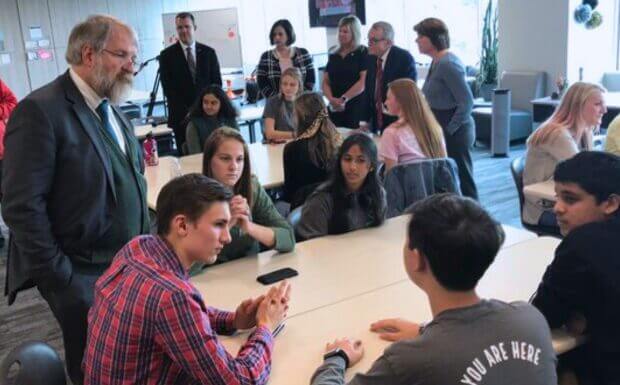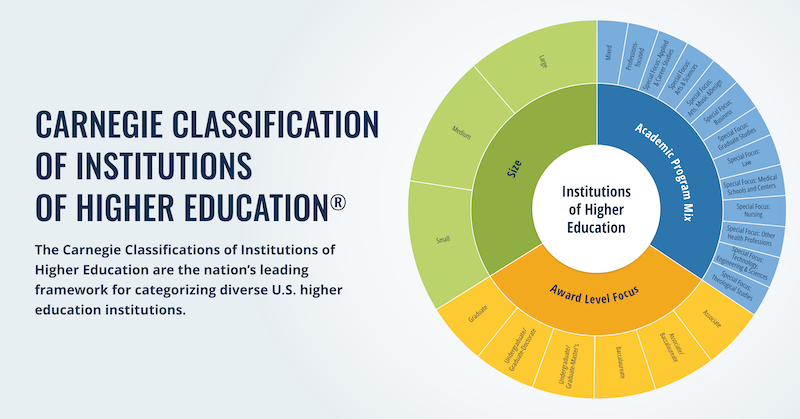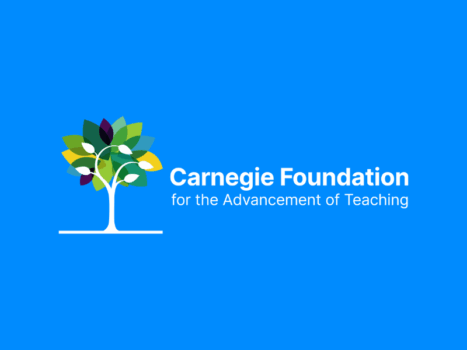Navigating Educational Transformation: A Q&A with State Board Leader Paolo DeMaria

Explore this thoughtful Q&A with National Association of State Boards of Education (NASBE) President and CEO Paolo DeMaria as he shares his journey as a public servant and state leader in Ohio as well as a nationally regarded education policy voice. Uncover Paolo’s perspective on the importance of state boards of education and read about the opportunities for transforming public education he believes state education leaders are facing today.
Paolo brings a wealth of policy knowledge and leadership experience to his current position at NASBE, where he leads the only organization dedicated solely to helping state boards promote excellence in public education. Paolo has held multiple senior leadership positions in state government in Ohio, concluding with his service as the State Superintendent of Public Instruction for five years. He has written several publications and speaks widely about change management, strategic planning, and college, career, and civic readiness.
Can you share your journey from your early days in education to becoming the President and CEO of NASBE? What did you see or experience in your professional journey that led you to your current role?
My journey in the field of education didn’t really start in education. I began my career as an intern with the Ohio State Legislature after graduating from Furman University, where I double-majored in Political Science and Economics. I learned about the state-level legislative process and how to influence decisions, and ultimately, this launched my 30-year career in state service. After working with the State Senate’s finance committee, serving as the State Budget Director, and Governor Taft’s Chief Policy Advisor and Director of Cabinet Affairs, I was appointed Associate Superintendent for School Options and Finance at the Ohio Department of Education. I then served as Executive Vice Chancellor of the Ohio Department of Higher Education. I also spent some time in the private sector as a consultant for Education First Consulting before I ultimately became the Ohio Superintendent of Public Instruction. In many of these roles, I worked with amazing board members, so I thought it would be rewarding to join the National Association of State Boards of Education as president and CEO.
When I reflect on my professional journey, two key aspects stand out: First, education is a fantastic policy area, perhaps even the most important for the success of our society. Many dedicated people work hard to create the best possible conditions for our children—who are our future—to succeed. A successful education system leads to successful communities, states, and ultimately, a successful nation. What better field is there to work in than education? Second, throughout this journey, I’ve recognized barriers that can prevent us from reaching our fullest potential and what we could do differently to enhance success. For instance, understanding how the public sector—whether legislative or executive, at the state board level or gubernatorial level—can catalyze positive change is crucial. Ultimately, I love the education space, the people in it, and I see wonderful things happening all the time across the country.
For those who are not as familiar, what is NASBE’s role and why do you think state boards of education are so critical to education today?
NASBE is a membership organization representing state boards of education across the country. At NASBE, we develop, support, and empower citizen leaders to strengthen public education systems. We facilitate engagement and provide services that enable state board members to be their best. We offer a full range of resources you might expect from a membership organization, including publications, convenings, professional development, and initiatives that help members assess barriers, enabling conditions, and opportunities for action and innovation.
State boards of education are critical for education today because they provide a place for citizens’ voices to be heard and create space for open and transparent deliberation about proposed policies. The relationship between Boards and State Education Agencies can also vary in important ways—some boards select their chief, for example, and others don’t. State board members can be elected, some appointed; they are often businesspeople, doctors, lawyers, or have held public office. Many have backgrounds in education, and some boards reserve a seat for a teacher representative and student members. No matter their composition or appointment process, Boards come together to reflect, deliberate, and help set the agenda and long-term vision for public education in their states. While a board may not be able to enact laws, the majority have primary authority over state assessments, graduation requirements, and determining teacher licensure requirements. State boards can also elevate issues based on data, research, and best practices from other states, and when they do this, they can catalyze important policy action and promote effective practices
What do you see as the biggest opportunities and challenges currently facing state boards of education?
We often spend too much time on disagreements when there’s actually a lot of common ground. For instance, everyone wants children to learn to read; this is not a partisan issue. While there are some areas of marginal disagreement, it’s important to focus on what we agree on and where we can make a difference.
Opportunities for state boards are numerous. For example, state boards have an opportunity to articulate what different and better learning looks like. This means clearly defining what students should know and be able to do, measuring that through assessments, and creating accountability structures that identify areas for improvement. However, history has shown that mandating different policies is not always the solution. There is still a strong desire for positive change, and many recognize that we need to adjust our approaches and provide support and professional development opportunities for educators to be successful. Ultimately, co-designing changes with educators, students, and families, rooted in data and best practices, is essential for fostering a collaborative environment that leads to real progress.
What work are you most excited about that NASBE is undertaking in the next year?
While it is difficult to choose one body of work, I am particularly excited about our upcoming high school transformation work given the energy surrounding it and the wonderful partners that are invested. I believe there’s immense potential for improvement in high schools because when you see a high school that’s a “rock star,” it makes you realize that every school could reach that level. Transforming the high school experience can be a fulcrum for catalyzing change in middle and elementary schools, and state boards of education are well-positioned to advance this work.
Our approach to high school transformation efforts is to catalyze interest and provide support to our members so they might drive more ambitious agendas. Over the next two years, NASBE will facilitate deeper engagement with state boards of education and build their capacity to lead high school transformation efforts. State boards can enable systems to deliver rich, rigorous high school experiences for every student. They often use what we call the ‘power to convene’ and the ‘power of the question’ to catalyze action. For example, the Indiana State Board of Education recently launched initiatives to make a high school diploma valuable for every graduate: It changed graduation requirements, streamlined learning standards, and developed a data dashboard aligned to key characteristics that students should acquire before graduating. The Indiana board continues to get feedback from stakeholders on making improvements to the new requirements.
We’ve learned that transformation does not necessarily require significant funding right away; it’s about getting people to agree on what better looks like and moving in that direction.
Given Carnegie’s focus on scaling high school transformation, in what ways are you seeing state boards of education rethinking secondary school, whether through transcripts, skill development, postsecondary pathways, etc.?
One key concept to highlight is the portrait of a graduate sweeping the nation, which is all about beginning with the end in mind. These portraits are beautiful depictions of what communities want their students to know and be able to do upon graduating from high school. If the goal is to prepare students for success, regardless of whether they choose a college track, vocational training, or other paths like apprenticeships or military service, then it’s essential to recognize the interconnectedness of disciplines and the need for students to develop essential skills along with academic knowledge. Of course, this requires some fundamental shifts in our system. We should not expect every student to excel in the same areas; instead, we need a system that accommodates diverse talents and allows for multiple paths to success.
The Kentucky State Board of Education adopted the Kentucky Portrait of a Learner in October 2022. The portrait serves as the foundation for the boards’ 2023 Call to Action to create more vibrant experiences for every student. The Kentucky Board, in partnership with the Kentucky United We Learn Council is also working to reimagine the school accountability system to ensure every student is learning what they need to learn in alignment with the portrait of a learner.
State boards are also exploring various ways to credential learning and acknowledge achievements outside conventional classroom settings. This includes allowing interdisciplinary approaches, such as teaching math in a science class or integrating social studies with literature.
The Washington State Board worked with the Mastery-based Learning Work Group to approve a Profile of a Graduate that has become the bridge between credit-based and mastery-based diplomas. Now the board is working to align its graduation requirements with the Profile by engaging stakeholders with the state’s high school graduation requirements and proposing new requirements over the next few years.
We all know that systems change is challenging work. What lessons did you learn in your role as State Superintendent of Public Instruction in Ohio that you would share with organizations like Carnegie that are trying to bring innovative practices to scale across complex systems?
Yes, systems change is hard work. Throughout my career, I have learned the power of collaboration, the importance of collective action, the necessity of holding people accountable, and the significance of good planning, implementation, and good communication. However, a few lessons stand out.
The first lesson is to bring people together, even those who might disagree with you, and have a conversation. For example, during the strategic planning process in Ohio, we involved many community members. We had an advisory group, held town meetings, and engaged the philanthropic and business communities. By the end of that process, people could see themselves in the work and felt positively about the changes we made, even if not all their input was included.
Another key element to successful change is that it’s not enough to simply have a plan; you need to implement it effectively. Change is difficult. I recommend the book Switch by the Heath Brothers, which emphasizes modeling the way and showing people what different looks like. I’m also a big advocate for visiting other schools doing great work, which allows for rich discussions about how to adapt those ideas in different environments. Upholding appropriate examples helps convey the message that success is possible. Providing support, a safe space, and time is essential. And sometimes, a servant leader who supports, enables, and encourages people doing the work can make a huge difference.
What inspires you most about the work being done by state boards across the nation?
What inspires me most is the people who are collectively working for the good of the education system. Recently, we had a New Member Institute where state board members shared their stories, passions, beliefs, and their “why.” Without exception, these are committed individuals who want what’s best for the students in their state. Finding common ground is crucial and, in this field, it is almost always about helping all kids be their absolute best and creating the conditions for them to reach their fullest potential. That’s what keeps me grounded. The fundamentals of what state boards are doing are great, and the people involved are committed, future-oriented, and optimistic. That’s what inspires me.
July 30, 2024
Earlier this year, the Carnegie Postsecondary Commission released its inaugural vision paper, “Revitalizing Higher Education: A Blueprint for Transformative Change.” As a precursor to this release, we commissioned the HEA Group to produce three baseline papers, as the Commission considered ideas and endeavors that will lead to transformational change of…
August 29, 2024
This is just a preview of what’s included in our August newsletter, featuring an opening letter from our president, Timothy Knowles. Click below to explore all the updates! Dear Friends and Colleagues, If you look closely at the landscape of secondary schooling across the nation, you will see a sea…







